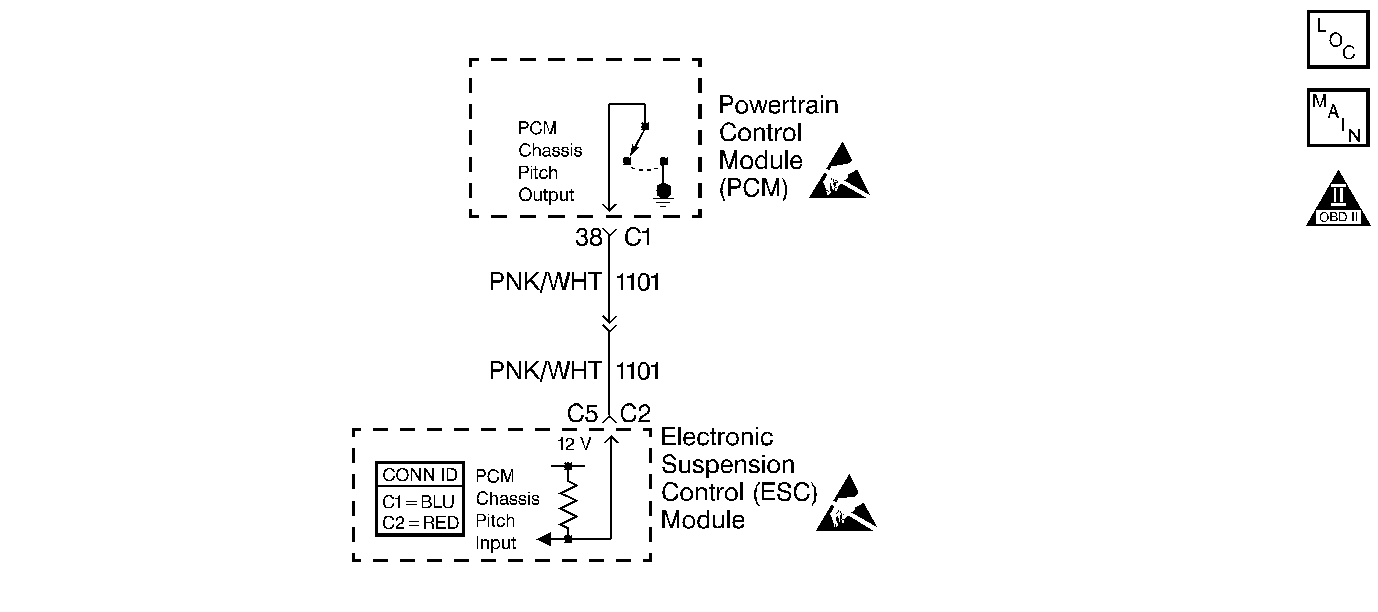
Circuit Description
The PCM controls the Powertrain Induced Chassis Pitch by grounding the control circuit via an internal switch called a driver. The primary function of the driver is to supply the ground for the controlled component. The driver has a fault line which is monitored by the PCM. When the PCM commands a component ON, the voltage of the control circuit should be low (near 0 volts). When the PCM commands the control circuit to a component OFF, the voltage potential should be high (near battery voltage). If the fault detection circuit senses a voltage other than what the system expects, the fault line status changes causing the DTC to set.
The PCM receives an ignition voltage feed from the electronic suspension control (ESC) module on the Powertrain Induced Chassis Pitch circuit. The PCM grounds this circuit when the vehicle accelerates rapidly or brakes hard. When the chassis pitch input circuit goes low (about 0 volts), the ESC module commands all four shock absorber solenoids to a firm position. The PCM calculates the chassis pitch information based on the engine torque and the vehicle braking force.
Conditions for Running the DTC
| • | Engine speed greater than 400 RPM. |
| • | The system voltage is greater than 6 volts but less than 18 volts. |
Conditions for Setting the DTC
| • | The PCM detects that the commanded state of the driver and the actual state of the control circuit do not match. |
| • | The condition must exist for a minimum of 5.0 seconds. |
Action Taken When the DTC Sets
| • | The powertrain control module (PCM) stores the DTC information into memory when the diagnostic runs and fails. |
| • | The malfunction indicator lamp (MIL) will not illuminate. |
| • | The PCM records the operating conditions at the time the diagnostic fails. The PCM stores this information in the Failure Records. |
Conditions for Clearing the DTC
| • | A last test failed, or current DTC, clears when the diagnostic runs and does not fail. |
| • | A history DTC will clear after 40 consecutive warm-up cycles, if no failures are reported by this or any other non-emission related diagnostic. |
| • | Use a scan tool in order to clear the DTC. |
Diagnostic Aids
Important:
• Remove any debris from the PCM connector surfaces before servicing
the PCM. Inspect the PCM connector gaskets when diagnosing/replacing
the module. Ensure that the gaskets are installed correctly. The
gaskets prevent contaminate intrusion into the PCM. • For any test that requires probing the PCM or a component
harness connector, use the Connector Test Adapter Kit J 35616
. Using this kit prevents damage
to the harness/component terminals. Refer to
Using Connector Test Adapters
in Wiring Systems.
| • | Ensure that the vehicle is equipped with electronic suspension control (ESC). This DTC sets when the body control module (BCM) is programmed if the regular production option (RPO) for the ESC is selected as active and the vehicle is not equipped with ESC. |
| • | For an intermittent condition refer to Symptoms . |
Test Description
The numbers below refer to the step numbers on the diagnostic table.
-
This step determines if the Powertrain Induced Chassis Pitch control circuit is shorted to ground.
-
This step determines if the Powertrain Induced Chassis Pitch control circuit is open or, the PCM is unable to control the Powertrain Induced Chassis Pitch control circuit.
Step | Action | Values | Yes | No |
|---|---|---|---|---|
1 | Did you perform the Powertrain On-Board Diagnostic (OBD) System Check? | -- | ||
Does the test lamp illuminate? | -- | |||
Command the Chassis Pitch Signal ON using the scan tool. Does the test lamp illuminate? | -- | Go to Diagnostic System Check in Real-Time Damping (RTD) | ||
4 |
Did you find and correct the condition? | -- | ||
5 |
Did you find and correct the condition? | -- | ||
6 |
Did you find and correct the condition? | -- | ||
7 |
Important: Program the replacement PCM. Replace the PCM. Refer to Powertrain Control Module Replacement . Is the action complete? | -- | -- | |
8 |
Does the scan tool indicate that this test ran and passed? | -- | ||
9 | Select the Capture Info option and the Review Info option using the scan tool. Does the scan tool display any DTCs that you have not diagnosed? | -- | System OK |
